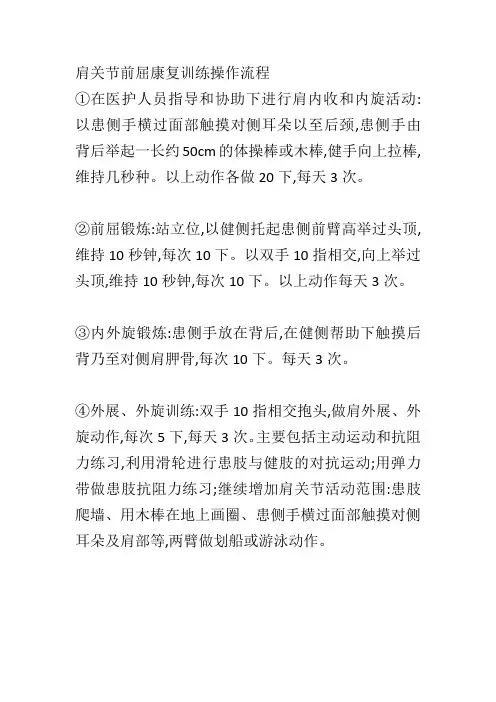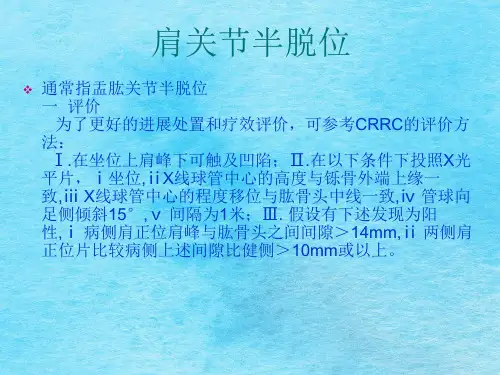肩关节康复课程
- 格式:ppt
- 大小:16.15 MB
- 文档页数:77






肩关节前屈康复训练操作流程
①在医护人员指导和协助下进行肩内收和内旋活动:以患侧手横过面部触摸对侧耳朵以至后颈,患侧手由背后举起一长约50cm的体操棒或木棒,健手向上拉棒,维持几秒种。
以上动作各做20下,每天3次。
②前屈锻炼:站立位,以健侧托起患侧前臂高举过头顶,维持10秒钟,每次10下。
以双手10指相交,向上举过头顶,维持10秒钟,每次10下。
以上动作每天3次。
③内外旋锻炼:患侧手放在背后,在健侧帮助下触摸后背乃至对侧肩胛骨,每次10下。
每天3次。
④外展、外旋训练:双手10指相交抱头,做肩外展、外旋动作,每次5下,每天3次。
主要包括主动运动和抗阻力练习,利用滑轮进行患肢与健肢的对抗运动;用弹力带做患肢抗阻力练习;继续增加肩关节活动范围:患肢爬墙、用木棒在地上画圈、患侧手横过面部触摸对侧耳朵及肩部等,两臂做划船或游泳动作。





肩关节前屈康复训练操作流程英文回答:Shoulder joint flexion is an important movement that allows us to reach forward and perform various activities. Rehabilitating the shoulder joint flexion requires a systematic approach to gradually restore the range of motion and strength. Here is a step-by-step guide on how to perform shoulder joint flexion rehabilitation exercises:1. Warm-up: Before starting any exercises, it is important to warm up the shoulder joint to increase blood flow and prepare the muscles for activity. This can be done by gently moving the shoulder joint in circles or performing shoulder rolls.2. Passive range of motion exercises: Begin by performing passive range of motion exercises to gently stretch the shoulder joint. This involves using the opposite hand or a towel to assist in moving the affectedarm into flexion. Start with small movements and gradually increase the range of motion over time.3. Active range of motion exercises: Once the passive range of motion has improved, it is time to move on to active range of motion exercises. This involves using the muscles of the shoulder joint to perform flexion. Examples of active range of motion exercises include shoulder flexion raises, wall slides, or arm circles.4. Strengthening exercises: As the range of motion improves, it is important to strengthen the muscles surrounding the shoulder joint. This can be done through various exercises such as dumbbell front raises, shoulder presses, or resistance band exercises. Start with light weights or resistance and gradually increase as strength improves.5. Functional exercises: Once the range of motion and strength have improved, it is important to incorporate functional exercises that mimic daily activities. This can include reaching for objects on a high shelf, liftingobjects overhead, or throwing a ball.6. Stretching: Finally, it is important to stretch the muscles surrounding the shoulder joint to maintainflexibility and prevent tightness. This can be done through static stretches or dynamic stretching exercises.Remember, it is important to progress gradually and listen to your body. If you experience pain or discomfort during any of the exercises, it is important to stop and consult with a healthcare professional.中文回答:肩关节前屈是一个重要的动作,使我们能够向前伸展并进行各种活动。
肩关节周围炎康复健康教育(1)保护肩关节:维持良好姿势,减少对患肩的挤压。
在疼痛时注意局部肩关节休息,防止过多活动,注意保暖。
在疼痛减轻时应尽量使用患侧进行功能训练。
(2)预防:避免局部外伤,如劳损、受压等。
工作要劳逸结合,肩关节劳损或损伤后及时治疗,老人应每日做各种体育锻炼太极拳等。
(3)康复指导:日常生活用健侧,适当配合患侧,进行正确有效的运动,可防止粘连,舒筋活血,改善局部血循环。
(4)拉轮练习:在墙或树上安滑轮,并穿过一绳,两端各系一小木棍,内外旋转动作,往复摆动锻炼。
活动范围逐渐增加,每天1—2次,每次20—30min。
(5)梳头动作:双手交替由前额、头顶、枕后、耳后、向前、纵向绕头一圈类似梳头动作,每组15—20次,每日3—5组。
(6)展翅练习呈站立位,上肢自然下垂,双臂伸直,手心向下缓缓向上用力抬起,到最大限度后停10s。
然后回到原处,反复进行。
(7)划圈练习:竖划圈前后方向竖划圈,患肢自然下垂,肘部伸直,患臂由前后划圈,幅度由小到大。
横划圈上下左右方式划圈,每次可顺时针或逆时针方向划圈各15—20圈,每天练习3—5次。
髋关节置换术后康复健康教育(1)饮食:病人麻醉清醒后6h即可给予流质,术后第一天后给普食,宜选用高蛋白、高钙、高维生素饮食,并补充足够水分。
(2)体位指导:采取平卧或半卧位,但患髋要屈曲<45度,不侧卧,患肢外展30度并保持中立,两腿间放臵外展架或厚枕,必要时准备合适的防旋鞋,将患者安排至有床上拉手的病床。
(3)指导正确使用拐杖:准备合适的双杖,使拐杖的高度及中部把手与患者的身高臂长相适宜,拐杖底端配胶装臵(防滑),拐杖的顶端用软垫包裹(减少对腋窝的直接压力),对术前能行走者训练其掌握使用方法,练习利用双杖和健腿的支撑站立,以及在患肢不负重状态下的行走。
(4)出院前要指导患者正确日常活动如更衣(穿裤时先患侧后健侧)、穿袜(伸髋屈膝进行)、穿鞋(穿无需系鞋带的鞋)。